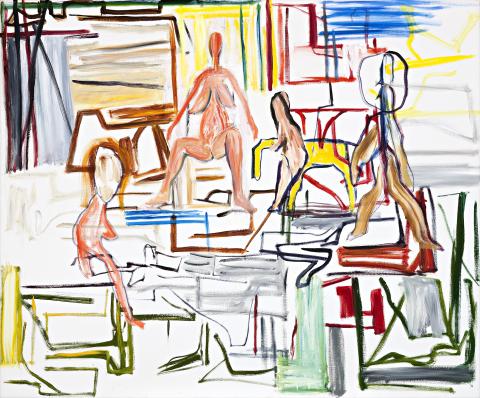BATHERS AND BRIGHT PAVILIONS, 1996
KEN WHISSON
oil on canvas
99.0 x 119.0 cm
signed, dated and inscribed with title verso: Ken Whisson / Painted: / Perugia. 4/3/96/+ 17/7/96 + 4/9/96/ + 28/11/96 / “Seaside 5. Bathers / and Bright Pavilions”
Watters Gallery, Sydney (label attached verso)
Private collection, Melbourne
Deutscher~Menzies, Melbourne, 28 November 2001, lot 22 (as ‘Seaside V: Bathers & Bright Pavillions’ [sic])
Private collection, New South Wales
Ken Whisson: Paintings and Drawings, Watters Gallery, Sydney, 22 October – 8 November 1997, cat. 9 (illus. in exhibition catalogue)
Ken Whisson has been exhibiting annually in Australia for decades. The consistency of his output over these exhibitions is unmatched and his often perplexing images are simply unique in Australian art. His 2012 retrospective exhibition at Sydney’s Museum of Contemporary Art and the Heide Museum of Modern Art in Victoria was testament to the high regard in which he is held.
In one way, it is possible to view these works as musical scores, or operatic narratives, where the artist uses his brush as a conductor uses a baton. The marks on the surface become a tangible record of emotional interpretation; however, Whisson replaces the score with his own imaginings. The very moment where the artist’s brush meets the canvas is the point where ideas crystallise, as the artist himself explains....
More directly in relation to where art comes from I have a distinct impression when working that the painting takes place at the point where the brush touches the canvas, and I believe that art is a result of a direct line of communication between the act of creation and a level of our being which is neither the conscious nor the famous sub-conscious, but which could be called the intuitive faculty, and which has to function without interference from the conscious thinking process.1
Indeed, it is Whisson’s highly tuned deftness of touch which is central to his practice and gives his work its distinctive drawn quality. Bathers and Bright Pavilions, 1996 is typical of Whisson’s mature work and is created in his usual method of working and reworking the painting over numerous painting sessions, sometimes spanning several months. The various titles, dates and inscriptions verso attest to this fluid process; each pictorial development intuitively dictates the next. Perhaps surprisingly, within this process each work remains a fresh, upbeat investigation into the margins between real and imagined worlds. The resulting pictures are just as likely to be recollections of a conversation about a place or event, as much as they may be visual depictions of the same.
This example is populated with his familiar repertoire of subjects; buildings, figures and animals are woven into the whole. A soft air of eroticism pervades the work as the nude figure makes her way around the narrative. Again, it is highly likely that the four figures, in a nod to cubism, represent a single figure at various intervals across time. Slabs of colour are spread evenly around the surface, which appear as walls or curtains and interrupt passages of paint which come dangerously close to conventional perspective.
There is a profound clarity or purity about Whisson’s paintings. Apart from early works where the influence of Danila Vassilieff and Sidney Nolan is evident, the majority are totally original paintings. The artist used his early influences as a springboard into his imagination, applied his own ideas about painting and never looked back. They are direct and uncompromised paintings in every way.
1. The artist cited in Ken Whisson Paintings 1947 – 1999, Niagara Publishing, Melbourne, 1985, p. 143
HENRY MULHOLLAND
